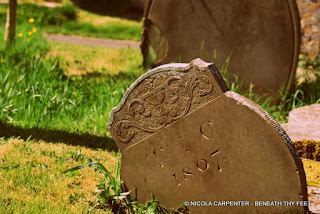 |
| Holy Trinity, Cookham, Berkshire. |
 |
| All Saints, Marlow, Buckinghamshire. |
Footstones were small headstone shaped stones placed at the foot of the grave, usually a reserve of the well to do, they only contained the initials and the year of death of those buried in the grave. As churchyards and cemeteries became crowded around the late 1850s and space a premium, footstones fell out of fashion. Today it is unusual to find footstones in situ, many have been either removed or placed against the headstone to aid grass cutting. Many more sadly fell victim to lawn cutting instruments and were damaged beyond repair.
Seen many and wondered what they were but I have taken photos of some in situ which I must post
ReplyDeleteOh please do. I have a little bit of the thing for footstones.
DeleteThat is fascinating... I never knew they were dubbed foot-stones.
ReplyDeleteBut surely the explanation for their disappearance is that the Victorians had to make a show of death, and so they went bigger and better with their gravestones?
Maybe, could be that they simply fell out of fashion. We all know what a fashionable bunch the Victorians were.
DeleteReally interesting! I'm not sure if I've seen these ---- or maybe just not recognized them for what they are. Nice post!
ReplyDeleteAnd thanks for hosting Cemetery Sunday. :)
Would you know why footstones were the 'reserve of the well-to-do'? I would have thought that the more well-off would have preferred larger, more ostentatious gravestones?
ReplyDeleteMany of the poorer people in society couldn't afford a private burial (not a paupers burial with others), let alone a stone to commemorate them. Sometimes those with some money could afford a private burial and a simple wooden cross or marker. Sandstone, slate and cast iron were usually for the middle or lower upper classes. It was mainly those with considerable income available that were able to afford a footstone to mark their grave as well as a gravestone.
DeleteThe larger, more ostentatious gravestones came into fashion during the middle to late Victorian era and footstones then fell out of favour.